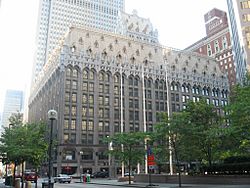Union Trust Building (Pittsburgh) facts for kids
Quick facts for kids Union Trust Building |
|
|---|---|

Exterior of the Union Trust Building on Grant Street in Downtown Pittsburgh
|
|
| General information | |
| Type | Offices |
| Location | 501 Grant Street, Pittsburgh, Pennsylvania |
| Coordinates | 40°26′24″N 79°59′49″W / 40.440°N 79.997°W |
| Completed | 1916 |
| Opening | 1917 |
| Cost | $1,497,000 |
| Owner | DIV 501 Grant Limited Partnership, an affiliate of The Davis Companies |
| Height | |
| Roof | 237 ft (72 m) |
| Technical details | |
| Floor count | 15 |
| Floor area | 550,000 sq ft (51,097 m2) |
| Lifts/elevators | 10 |
| Design and construction | |
| Architect | Frederick J. Osterling |
| Developer | Henry Clay Frick |
| Main contractor | George A. Fuller Company |
|
Union Trust Building
|
|
| Location | 501 Grant St. Pittsburgh, Pennsylvania |
| Area | 1 acre (0.40 ha) |
| Built | 1916 |
| Architect | Graham, Anderson, Probst & White; Harry L. Widom |
| Architectural style | Renaissance, Gothic, French Renaissance |
| NRHP reference No. | 74001748 |
| Significant dates | |
| Added to NRHP | January 21, 1974 |
The Union Trust Building is a very tall building located in the downtown area of Pittsburgh, Pennsylvania. It stands at 501 Grant Street. A famous businessman named Henry Clay Frick had it built between 1915 and 1916. This building has a unique Flemish-Gothic style. It was first designed to be a large shopping center.
Contents
Building History
Early Days as a Shopping Arcade
When it first opened, the building was called the Union Arcade. It was a huge shopping area with 240 different shops and art galleries. The roof of the building is very special. It's a type of roof called a mansard roof. This means it has four slopes, and the lower part of each slope is steeper than the upper part.
The roof is decorated with terra cotta dormers. These are window structures that stick out from the sloped roof. There are also two towers on the roof that look like small chapels. Inside the building, there's a big open space in the middle called a rotunda. This rotunda is covered by a beautiful stained-glass dome. The Union Trust Building is so important that it's listed on the National Register of Historic Places.
Who Designed It?
The building was designed by an architect named Frederick J. Osterling. It was built where Pittsburgh's old St. Paul's Catholic Cathedral used to be. People have suggested that its design might have been inspired by buildings like the Brussels Town Hall or the Leuven Town Hall, both in Europe. The Woolworth Building, a famous skyscraper built around the same time, might also have been an influence.
Another person, Pierre A. Liesch, also helped Osterling with the design. Liesch was from Luxembourg. He later used a similar style for another building, the Croatian Fraternal Union Building.
Changing Names and Owners
In 1923, a company called the Union Trust Company bought the building. They changed its name from the Union Arcade to the Union Trust Building. They also updated the first four floors of the building.
The Roof Story: Fact or Fiction?
Many people in Pittsburgh have heard a fun story about the building's unique roof. The story goes that when Henry Clay Frick bought the land from the church, the church leaders put a special rule on the land. This rule supposedly said that even though it would be a business building, people should always remember the church that used to be there.
Another version of the story says that a place of worship must always be on the site. So, some people believe there's a secret chapel hidden in one of the towers to follow this rule. However, these are just urban legends – fun stories that aren't true. There was no such rule or restriction when the land was sold in 1901.
Recent Changes and Renovations
Over the years, the building has had several owners. In 1984, Edward J. DeBartolo, Sr., who owned sports teams like the San Francisco 49ers and Pittsburgh Penguins, bought the building.
Later, in 2008, it was bought by investors from California. By 2012, the building faced some financial problems.
In 2014, the building was sold again at an auction for $14 million. It was bought by a company from Boston called The Davis Companies. This company spent a lot of money, about $100 million, to fix up and restore the building. These big renovations were finished in 2016. As part of the updates, two new restaurants opened on the first floor. There's also a theater on the tenth floor that is still being restored.
Images for kids


